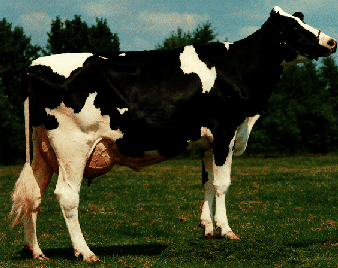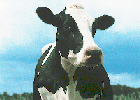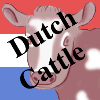
Great dairy expression, youthfulness, slightly sloped rump angles and
wedgeshaped bodies are desired for first-lactating heifers in the Netherlands


a strong dairy cow with a wedgeshaped body from the top as well as in side view and with a slightly sloped rump angle
The more a cow corresponds to this standard, the higher the score for type. All scores between 65 and 94 points are possible for first-lactating heifers.

When scoring type, great emphasis is given to dairy expression. The cow should show not only the will to produce large quantities of milk, but also the power to do this. The linear descriptive traits body depth, rump angle, rump width and muscularity are regarded as optimum traits, when coming to a score for type. In other words, a 9 for these traits does not lead to the highest type score.
The body depth should be somewhat above average. Longer rear ribs go hand in hand with a wedgeshaped body and are therefore desirable. Much body depth is required with respect to the roughage intake capacity. Roughage is an inexpensive feedstuff and therefore body depth can have an economic influence. On the other hand extreme body depth for first-lactating heifers, in particular, is less desirable due to its relation width bodyweight and consequently with production efficiency. In view of a desired degree of youthfulness of first-lactating heifers extreme body depth is less desirable, because it could go hand in hand with early-maturing animals. Very shallow-bodied cows are in general frailer and might produce less and therefore penalized in type-scoring.
A slightly sloped rump angle is preferred since it is reported to be benificial to calving ease and overall fertility.
Rump width is given less emphasis than body depth and rump angle in type-scoring. Narrow cows are less desired, since higher incidences of calving difficulties in regard to these cows are reported. A rump width score of 3 to 5 is considered to be optimal. A higher score might go hand in hand with heavier cows and consequently less efficient dairy cows.
The same goes for muscularity. A muscularity score of 3 to 5 is considered to be optimal. Less muscularity can be a sign of frailness; cows having much muscularity are lacking dairyness. A muscularity score of 9 is not desirable in regard to herdlife and milk production.
Moreover, the front end is taken into consideration in type-scoring. Small front ends could result in frailness. Cows with too much capacity in front often have a less wedgeshaped body and are therefore less desirable with regard to dairy character. Last but not least, a strong top line helps cows to get a good type score.